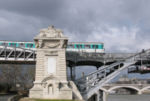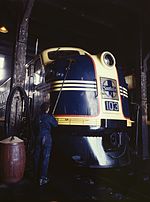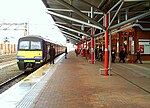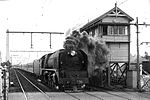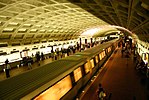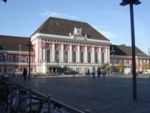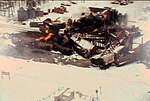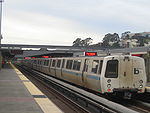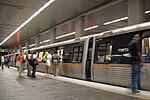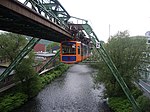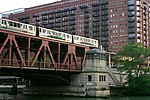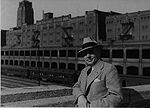Portal:Trains/Selected article/2007 archive
This is an archive of article summaries that have appeared in the Selected article section of Portal:Trains in 2007. For past archives, see the complete archive page.
Caltrain is a commuter rail line on the San Francisco Peninsula and the Santa Clara Valley in the U.S. state of California. It is currently operated under contract by Amtrak and funded jointly by City and County of San Francisco, San Mateo County Transit District, and Santa Clara Valley Transportation Authority through the Peninsula Corridor Joint Powers Board. Caltrain's northern terminus is in eastern San Francisco, at 4th and King streets, and its southern terminus is in Gilroy. Trains operate out of San Francisco and San Jose on a half hourly basis every weekday, with more frequent service provided during commute hours, along with three daily commute-hour round trips extending to Gilroy. Also, hourly train service is provided during weekends and holidays. Weekday ridership in February 2006 was 32,031 boardings. As of 2006[update], Caltrain has 29 regular stops, one football-only stop (Stanford Stadium), and two weekend-only stops (Broadway and Atherton). Caltrain operates a mix of 96 local, limited, and express weekday trains, with 32 and 28 hourly local trains on Saturdays and Sundays, respectively.
Recently selected: Paddington station - SkyTrain (Vancouver) - Beeching Axe
- Week 2
- January 7-January 13
The Paris Métro (French: Métro de Paris) is the rapid transit system in Paris, France. It includes 16 lines, primarily underground, with a total route length of 211 km (131 miles). The system, which has become one of the symbols of Paris, is notable for the density of its network in central Paris, and for its homogeneous architectural style, influenced by Art Nouveau. The initial line was inaugurated in 1900, during the Exposition Universelle world's fair. The core of the Métro network was complete by the 1920s, and the system was expanded quickly until the outbreak of the Second World War. The first extensions across the municipal boundary into adjacent suburbs were built during the 1930s. After a pause during the "automobile decades" (décennies voitures) of 1950-1970, several suburban extensions were built. Technical decisions dating to the design of the original network, such as short distances between stations and small-profile trains, limit prospects for expansion. Today, the Métro transports approximately 4.5 million passengers per day (1.365 billion for the year 2005). It serves 297 stations, of which 62 provide connections with another line.
Recently selected: Caltrain - Paddington station - SkyTrain (Vancouver)
- Week 3
- January 14-January 20
The EMD BL2 is a four-axle B-B road switcher built by General Motors Electro-Motive Division (EMD). Often considered the "Ugly Duckling" of diesel offerings from EMD, the BL2 set the stage for the company's widely successful GP series of locomotives. EMD's diesel program was well underway in the late 1940s and early 1950s, thanks to the success of the company's FT demonstrations across the country. While the F-units in production were great for moving trains over the railroad, their full-width carbody made it difficult for locomotive crews to see to the rear of the locomotive. The F-units also lacked anywhere for a brakeman or switchman to stand and ride short distances while performing switching duties. Another problem facing EMD was that ALCO was making inroads into a market that EMD would have liked to keep to themselves; ALCO's RS series switchers were starting to take over many of the tasks that EMD wanted to fulfill with their own locomotives. EMD's designers and engineers set to work and came up with the carbody reminiscent of the GG1 with mechanics that contained the technical knowledge they had learned with the company's F-unit series. This model of locomotive was sold for both freight and passenger service and the locomotive's intended purpose could be easily identified by the presence or absence of an exhaust stack between the two windshield panes. This exhaust stack was for the steam generator on passenger service units. EMD's engineers learned quite a bit from the endeavor and incorporated all of the good ideas from it into the company's widely successful GP series of locomotives.
Recently selected: Paris Métro - Caltrain - Paddington station
- Week 4
- January 21-January 27
The Ladbroke Grove rail crash (also known as the Paddington train crash) was an English rail accident which occurred on 5 October 1999, in which thirty-one people died. The disaster occurred at 08:08 and 58 seconds BST, when a three-car Class 165 diesel multiple unit train operated by Thames Trains collided with a High Speed Train (8 coaches with a diesel power car at each end) of First Great Western at Ladbroke Grove Junction, about two miles (4 km) west of the terminus at London Paddington station. The trains collided almost head-on at the junction with a combined closing speed of approximately 130 mph (205 km/h). The first car of the Thames Train, the 0806 from Paddington to Bedwyn, Wiltshire, driven by Michael Hodder, was totally destroyed on impact, and the diesel fuel carried by this train ignited, causing a series of separate fires in the wreckage, particularly in coach H at the front of the HST, which was completely burnt out. 31 people were killed as a result of the incident, including the drivers of both trains; 227 people were hospitalised and 296 people were treated at the site of the crash for minor injuries.
Recently selected: EMD BL2 - Paris Métro - Caltrain
- Week 5
- January 28-February 3
The Qingzang railway, Qinghai–Xizang railway, or Qinghai–Tibet railway (simplified Chinese:
Recently selected: Ladbroke Grove rail crash - EMD BL2 - Paris Métro
- Week 6
- February 4-February 10
The Northern Pacific Railway (reporting mark NP) was a railway that operated in the north-central region of the United States. The railroad served a large area, including extensive trackage in the states of Idaho, Minnesota, Montana, North Dakota, Oregon, Washington and Wisconsin. The company was headquartered first in Brainerd, Minnesota, then in St. Paul, Minnesota. The Northern Pacific was chartered on July 2, 1864 as the first northern transcontinental railroad in the United States. Groundbreaking did not take place until February 15, 1870, at Thompson Junction, Minnesota, 25 miles (40 km) west of Duluth. The backing and promotions of famed Civil War financier Jay Cooke in the summer of 1870 brought the first real momentum to the company. The Northern Pacific survived bankruptcy and the Panic of 1873 due to austerity measures put in place by company president Cass. The transcontinental line was completed with a golden spike ceremony September 8, 1883, at Gold Creek, Montana. Almost a century later consolidation in American railroading brought the Northern Pacific together with the Chicago, Burlington and Quincy Railroad, Great Northern Railway and the Spokane, Portland and Seattle Railway on March 2, 1970, to form the Burlington Northern Railroad.
Recently selected: Qingzang railway - Ladbroke Grove rail crash - EMD BL2
- Week 7
- February 11-February 17
The Docklands Light Railway (DLR) is a light rail system serving the redeveloped Docklands area of east London, England. It extends to Stratford to the north, Greenwich and Lewisham to the south, west close to London city centre and east to the rest of the Docklands, London City Airport and eventually Woolwich (currently North Woolwich). The DLR has separate tracks and rolling stock from the London Underground, but the two systems share a ticketing system and the DLR appears on the London Underground’s Tube map. All the trains are computer-controlled and have no driver: a passenger service agent (PSA) on each train is responsible for patrolling the train, checking tickets, making announcements, and controlling the doors. PSAs can also take control of the train in case of computer failure or emergency. Overground stations are unstaffed and underground stations staffed, with a few exceptions. Operation and maintenance of the DLR has been carried out by a private franchise since 1997. The current franchise, due to expire in April 2013, belongs to Serco Docklands Ltd, a company jointly formed by Serco and the former DLR management team. The DLR system is undergoing constant expansion, with 38 stations currently on the system.
Recently selected: Northern Pacific Railway - Qingzang railway - Ladbroke Grove rail crash
- Week 8
- February 18-February 24
In Whyte notation, a 2-8-0 is a railroad steam locomotive that has a single-axle leading truck followed by four powered driving axles. In the US, this wheel arrangement is commonly called a Consolidation. The equivalent UIC classification is 1-D. The first locomotive of this wheel arrangement was likely built by the Pennsylvania Railroad (PRR), but like the first 2-6-0s, this first 2-8-0 had a leading axle that was rigidly attached to the locomotive's frame. To create this 2-8-0, the PRR's master mechanic John P. Laird modified an existing 0-8-0, the Bedford, between 1864 and 1865. However, some railroad historians believe the first 2-8-0 was ordered by Lehigh and Mahoning Railroad (also in the USA), which named the new locomotive Consolidation. The 2-8-0 wheel arrangement soon found frequent and heavy use in freight service around the world.
Recently selected: Docklands Light Railway - Northern Pacific Railway - Qingzang railway
- Week 9
- February 25-March 3
A caboose (US railway terminology) or brake van or guard's van (British terminology) is a manned rail transport vehicle coupled at the end of a freight train. Although cabooses were once used on nearly every freight train in North America, their use has declined and they are seldom seen on trains, except on locals and smaller railroads. The caboose provided the train crew with a shelter at the rear of the train. From here they could exit the train for switching or to protect the rear of the train when stopped. They also used windows to inspect the train for problems such as shifting loads, broken or dragging equipment, and overheated journals (hot boxes). The conductor kept records and otherwise conducted business from a table or desk in the caboose. For longer trips the caboose provided minimal living quarters, and was very frequently personalized and decorated with pictures and posters. Until the 1980s, laws in the United States and Canada required that all freight trains have a caboose. Technology eventually advanced such that a caboose was unnecessary, providing improved bearings and lineside detectors to detect hot boxes, and better designed cars to avoid problems with the load.
Recently selected: 2-8-0 - Docklands Light Railway - Northern Pacific Railway
The Trondheim Tramway located in Trondheim, Norway, consists presently of one 8.8 km tramway line, Gråkallbanen, from St. Olav's Gate in the city centre through Byåsen to Lian Station in Bymarka. The line, Line 1, is operated by Gråkallbanen AS and is often simply called Gråkallbanen. Gråkallbanen operates six tram cars, in addition to heritage cars run by Trondheim Tramway Museum. Previously there were three lines in Trondheim, including Ladelinjen to Lade and Singsakerlinjen to Singsaker in addition to tracks to Ila, Elgeseter, Trondheim Central Station and Lademoen. The line to Singsaker was closed in 1968 while the rest of the network was closed in 1983 and 1988, though the line to Lian was reopened in 1990. The tramway is the most northerly line in the world, after the Arkhangelsk tram was closed on July 24, 2004. Trondheim is also unique in that it is one of two railways in Norway using metre gauge track (the other is the heritage railway Thamshavnbanen) and that the tramway is one of two systems in the world to use 2.6 m wide cars on metre gauge track.
Recently selected: Caboose - 2-8-0 - Docklands Light Railway
The EMD FT was a 1,350 hp (1,010 kW) B-B diesel-electric locomotive produced between November 1939 and November 1945 by General Motors' Electro-Motive Division. 555 cab-equipped A units were built, along with 541 cabless booster B units, for a total of 1,096 locomotive units constructed, all sold to customers in the United States. It was the first model in EMD's very successful F-unit series of cab unit freight diesels, and was the locomotive that convinced many US railroads that the diesel-electric freight locomotive was the future, and that EMD was the manufacturer that could make it happen. Many rail historians consider the FT one of the most important locomotive models of all time. FTs were generally marketed as semi-permanently coupled A+B sets (a lead unit and a cabless booster connected by a drawbar) making a single locomotive of 2,700 hp. Many railroads used pairs of these sets back to back to make up a four-unit A+B+B+A locomotive rated at 5,400 hp. Some railroads purchased semi-permanently coupled A+B+A three-unit sets of 4,050 hp, while a few, like the Santa Fe, ordered all their FTs with regular couplers on both ends of each unit, for added flexibility. All units in a consist could be run from one cab; multiple unit (MU) control systems linked the units together.
Recently selected: Trondheim Tramway - Caboose - 2-8-0
The Berlin Stadtbahn ("city railway") is a major railway thoroughfare in the German capital Berlin. The line was originally built in the 1880s and runs through Berlin from east to west. It connects the eastern borough of Friedrichshain and Charlottenburg via the stations of Berlin Ostbahnhof, Alexanderplatz, Friedrichstraße, Hauptbahnhof, and Zoologischer Garten. The Stadtbahn line mostly is built as an elevated rail line with viaducts totaling eight kilometres of length and including 731 masonry viaduct arches. Two kilometres of the line length are situated on 64 bridges, and the remaining length of the 12 km line is on an embankment. This sets the Stadtbahn apart from the previous Berliner Verbindungsbahn, built in 1851, which was built at street level and was a hindrance to travel. The Stadtbahn was originally equipped with vertical iron sleepers, however these were replaced with wooden sleepers in the early 20th century. Until the summer of 2006, the Stadtbahn was the main thoroughfare for long-distance trains, which usually stopped at Zoologischer Garten and Ostbahnhof (which was renamed in 1998). When the new Hauptbahnhof opened on May 28, 2006, the importance of the line diminished slightly, as many trains now would use the new north-south line connected to the Hauptbahnhof. The remaining intercity trains on the Stadtbahn, mainly those heading toward Hanover and Cologne, now usually call at Hauptbahnhof and Ostbahnhof.
Recently selected: EMD FT - Trondheim Tramway - Caboose
Rugby railway station serves the town of Rugby in Warwickshire, England. It opened during the Victorian era, in 1885, replacing earlier stations situated a little further west. Since the closure of the station on the now-abandoned Great Central Railway route through the town, it is Rugby's only station. Situated on the West Coast Main Line (WCML) connecting London to Birmingham and the North West, the present station, managed by Virgin Trains, is located roughly half a mile north of Rugby town centre. On the WCML as a whole, it is located 82 miles (132 km) north of London Euston, and 319 miles (513 km) south of Glasgow Central. Main line train services into Rugby are operated by Virgin Trains and local services by Central Trains. There are regular services to London, Birmingham, Northampton, the North West, and a limited direct service to Glasgow.
Recently selected: Berlin Stadtbahn - EMD FT - Trondheim Tramway
Trams in Adelaide are represented by a single tram line connecting the central business district of Adelaide, South Australia, to the seaside suburb of Glenelg, and two classes of electric trams built in 1929 and 2006. Until 1958 this line was part of a network spanning most of suburban Adelaide, with origins dating back to 1878. Adelaide operated with horse trams from 1878 to 1914, electric trams from 1909 to 1958 and has primarily relied on buses for public transport since. Early use of trams was for recreation rather than solely daily travel, with entire families and tourists being transported. Until the 1950s trams were used for family outings so much that the Municipal Tramways Trust (MTT) constructed Kensington Gardens and extended the Kensington line to attract customers. By 1945 the MTT was collecting fares for 95 million trips annually, representing 295 trips per head of population. After the Great Depression maintenance of the tramway system and the purchase of new trams suffered. Competition by private buses, the MTT's own bus fleet and the growth of private car ownership all took patrons from the tram network. By the 1950s, the tram network was losing money and being replaced by an electric and petrol bus fleet. Adelaide's tram history is preserved by a volunteer run museum and tramway at St Kilda, and the continuing use of 1929 H Class trams on the remaining Glenelg tram line.
Recently selected: Rugby railway station - Berlin Stadtbahn - EMD FT
An SD26 is a diesel-electric locomotive developed and used in the western United States. The SD26 was essentially an EMD SD24 diesel locomotive that was specially modified by the Atchison, Topeka and Santa Fe Railway (the Santa Fe) in the mid-1970s. In an effort to spare the cost of purchasing new motive power, the Santa Fe elected to expand on the success of its CF7 and other capital conversion programs and extend the life of its fleet of 80 aging SD24s by rebuilding them at its San Bernardino, California, workshops from January 1973 through January 1978. The rebuilt locomotives saw service throughout much of the Santa Fe system. Over half the SD26s were retired by Santa Fe in 1985 and replaced with then state-of-the-art equipment, while a year later the remaining units were sold to Guilford Transportation Industries (now known as Pan Am Systems), two of which are still in service as of 2007.
Recently selected: Trams in Adelaide - Rugby railway station - Berlin Stadtbahn
The history of rail transport in Australia dates almost to the decade of the first commercial railways in the world. Following the British model, Australians generally assumed in the 1850s that railways would be built by the private sector. Private companies attempted to build railways in the colonies (states after Federation in 1901) of New South Wales, Victoria and South Australia. The first line opened in South Australia in 1854 as a horse-drawn line, while the first steam-powered line opened in Victoria a little later in 1854. It was soon established that the private railways were not financially viable, and the building of rail networks was taken over by colonial governments. This also enabled railways to be developed to promote development, even if not apparently viable in strictly financial terms. The railway systems spread from the colonial capitals, except in cases where geography dictated a choice of an alternate port. The colonial railways were built to three different gauges, which became a problem once lines of different systems met at Albury, New South Wales, in 1881 and Wallangarra, Queensland, in 1888. In the 20th century, the lines between major cities were converted to standard gauge and electrified suburban networks were built in Sydney, Melbourne, Brisbane and Perth. In the second half of the 20th century, many rural branch lines were closed to passengers or altogether in all states. On the other hand, long heavy-haul railways were built to transport iron ore in Western Australia and coal in Queensland to ports.
Recently selected: SD26 - Trams in Adelaide - Rugby railway station
The Washington Metro, or simply Metro, is the rapid transit system of Washington, D.C., and neighboring suburban communities in Maryland and Virginia, both inside and outside the Capital Beltway. In Maryland, service is provided in Prince George's County and Montgomery County; in Virginia, service extends to Fairfax County, Arlington County, and the city of Alexandria. The Metrorail (subway) system and the Metrobus (bus) network are owned and operated by the Washington Metropolitan Area Transit Authority (WMATA) — a multijurisdictional, quasi-governmental agency. WMATA also operates a paratransit service for the disabled called MetroAccess. However, the expression "Metro" usually refers to Metrorail exclusively. Since opening in 1976, the subway network has grown to five lines, consisting of 86 stations and 106.3 miles (171 km) of track. The original plan of 83 stations on 103 miles (165.5 km) was completed on January 13, 2001. There were 206 million trips on Metrorail in fiscal year 2006. The system is the second busiest in the United States, after the New York City Subway system, with about 700,000 trips taken on a typical weekday.
Recently selected: History of rail transport in Australia - SD26 - Trams in Adelaide
The Channel Tunnel Rail Link (CTRL) is a project to construct a 108 km (67 mi) high-speed railway line from London through Kent to the British end of the Channel Tunnel. A high-speed rail line has been in operation on the French section of the Eurostar rail link since the Channel Tunnel's opening in 1994, carrying trains at 300 km/h (186 mph). A similar high-speed line from the French border to Brussels opened in 1997. In Britain, long-distance trains have had to share track with local traffic, limiting average speeds and the number of services that can be run. In addition, the general state of Britain's rail infrastructure has caused frequent and unpredictable delays, reducing the appeal of the Eurostar service. Originally, the whole route was to be constructed as a single project. However, in 1998 it ran into serious financial difficulties and with its future looking uncertain the project was split into two separate phases. The second section of the CTRL, traveling across the River Thames and into London St Pancras is scheduled to open on 14 November 2007. Once open, it will cut 20 minutes from the current Eurostar journey times, making it possible to travel from London St. Pancras to Paris Gare du Nord in 2 hours 15 minutes and to Brussels in 1 hour 51 minutes. On 14 November 2006, London and Continental Railways adopted the branding High Speed 1 (HS1) for the completed Channel Tunnel Rail Link.
Recently selected: Washington Metro - History of rail transport in Australia - SD26
The Tyne and Wear Metro (known simply as the Metro) is a light rail metro system based around Newcastle upon Tyne and Sunderland, in the metropolitan county of Tyne and Wear in North East England. The network opened in 1980, and in 2005-2006 provided 36.6 million public journeys on its 77.5 km (48.2 mi) route. It is operated by the Tyne and Wear Passenger Transport Executive (TWPTE) operating as Nexus. Nexus also operates a passenger ferry service at the mouth of the River Tyne between North Shields and South Shields, and several bus services around the Tyne and Wear area. The Metro is usually described as Britain's first modern light rail system. However, it can be considered a hybrid system, displaying elements of light rail, heavy underground metro, and longer-distance, higher speed suburban and interurban railway systems. The Metro alignment comprises most of two of the world's oldest passenger railways, the Newcastle & North Shields Railway (Metro between Chillingham Road and North Shields) and the Brandling Junction Railway (between Gateshead and Monkwearmouth, near the Stadium of Light); both opened in 1839, making the Metro arguably one of the world's oldest local rail transport systems.
Recently selected: Channel Tunnel Rail Link - Washington Metro - History of rail transport in Australia
El Gobernador was a 4-10-0 steam locomotive built by Central Pacific Railroad at the railroad's Sacramento, California, shops in 1883. It was the last of Central Pacific's locomotives to receive an official name and was also the only locomotive of this wheel arrangement to operate on United States rails. At the time it was built, El Gobernador was the largest railroad locomotive in the world. Its name is reminiscent of the railroad's first locomotive, Gov. Stanford, as El Gobernador is Spanish for The Governor. This locomotive is sometimes mistakenly referred to as a "Mastodon" type. However, this was the unofficial name for an earlier engine, No. 229, the first 4-8-0 ever built. Both engines looked nearly identical, except that El Gobernador was longer and had an additional pair of drivers. El Gobernador was scrapped in 1894.
Recently selected: Tyne and Wear Metro - Channel Tunnel Rail Link - Washington Metro
Hamm (Westfalen) (often abbreviated Hamm (Westf) or simply Hamm (W)) is a railway station situated in the city of Hamm in the German state of North Rhine-Westphalia. The station at Hamm was opened on May 2, 1847, when the first train of the Köln-Mindener Eisenbahn reached the city. A major reconstruction began in 1911 to expand the station facilities due to increased demand; a separate marshalling yard was built in the 1880s, the railway lines were put on elevated embankments, the trackbed inside the station was raised and the original station building was torn down and replaced with the current building. The station building was inspired by Art Deco and Gründerzeit building styles. The station is one of the important InterCityExpress rail hubs in the eastern Ruhr area and is among the high-profile buildings of Hamm.
Recently selected: El Gobernador - Tyne and Wear Metro - Channel Tunnel Rail Link
The ALCO DL-109 is one of six models of A1A-A1A diesel locomotives built to haul passenger trains by the American Locomotive Company (ALCO) between December 1939 and April 1945. They were of a cab unit design, and both cab-equipped lead A units DL-103b, DL-105, DL-107, DL-109 and cabless booster B units DL-108, DL-110 models were built. The units were styled by the industrial designer Otto Kuhler, who incorporated the trademark 3-piece windshield design. A total of 74 cab units and 4 cabless booster units were built. The different models were sequentially offered and all developed 2,000 hp (1,500 kW). The differences between the cab units DL-105, DL-107, DL-109 and between the booster units DL-108 and DL-110 were minor. The first unit built to ALCO Specification DL-103b, the Chicago, Rock Island and Pacific Railroad #624, was 4 ft 5 in (1.3 m) longer than the other cab units. The DL-103b had the two radiator sections positioned together at the end of the carbody, while all other units had a split radiator arrangement with one placed at the back of the unit and one situated in the middle. The DL-103b was built with twin straight-6-cylinder ALCO 538T diesel engines as prime movers; all other DLs in this series were built with the newer twin straight-6-cylinder ALCO 539T diesel engines. The DL-103b also had all-electric driven accessories, while the later models had belt-driven accessories.
Recently selected: Hamm (Westfalen) railway station - El Gobernador - Tyne and Wear Metro
The West Country and Battle of Britain Classes, also known as Bulleid Light Pacifics or 'Spam Cans,' are classes of streamlined 4-6-2 steam locomotives designed for the Southern Railway in Great Britain by Oliver Bulleid. Sixty members of both classes were subsequently rebuilt by British Railways during the late 1950s. Intended for express passenger and semi-fast work in South-East and South-West England, 110 of them were eventually built incorporating many innovations previously used on the SR Merchant Navy Class. The classes operated until the end of Southern steam in July 1967, and many examples of the class have been preserved, and can be seen on heritage railways throughout Britain.
Recently selected: ALCO DL-109 - Hamm (Westfalen) railway station - El Gobernador
The Weyauwega derailment was a railroad accident that occurred in Weyauwega, Wisconsin, USA, in the early morning hours of March 4, 1996. The derailed cars included 7 tank cars of liquefied petroleum gas (LPG), 7 tank cars of propane and two tank cars of sodium hydroxide. The derailment ruptured three of the tank cars and spilled both LPG and propane, which immediately ignited. The fire, which involved the train cars themselves and an adjacent feed mill, burned for more than two weeks after the actual derailment, and resulted in the emergency evacuation of 2,300 people for 16 days; notably, the entire city of Weyauwega was evacuated, with about 1,700 evacuees alone. A subsequent NTSB investigation found the cause of the derailment to be a broken rail within the turnout that was the result of an undetected bolt hole fracture. Nine individuals who were affected by the evacuation filed a class action lawsuit seeking punitive and treble damages against Wisconsin Central on March 26, 1996. By the end of the year, thirteen more families and two business joined the suit against the railroad, and another business filed a separate suit for damages in Waupaca County District Court. In 1998, the railroad estimated the costs from the derailment and class action suit to be valued at $28 million, of which Wisconsin Central had paid $27.2 million by the end of 1998.
Recently selected: SR West Country Class - ALCO DL-109 - Hamm (Westfalen) railway station
Timothy Beach Blackstone (March 28, 1829 – May 26, 1900) served as president of the Chicago and Alton Railroad from 1864 through 1899. Blackstone was born in Branford, Connecticut, the sixth child, and fourth son, of James Blackstone and Sarah Beach. Health issues caused Blackstone to drop out of school in 1847, and he began working for Roswell B. Mason, surveying the New York and New Haven Railroad. He only worked on the NY&NH for a year before becoming an assistant engineer on the Stockbridge and Pittsfield Railroad. Again, he only remained with the firm a short time before leaving for the Vermont Valley Railroad. In 1851, Roswell invited Blackstone to supervise construction of the Illinois Central Railroad between Bloomington and Dixon, Illinois. Blackstone accepted the job and moved to La Salle, Illinois. Blackstone was elected mayor of LaSalle in 1854 and served a single term, his only foray into elected office. After leaving office, he returned to working on railroads, first as chief engineer of the Joliet and Chicago Railroad, which would eventually become the Chicago and Alton Railroad. Blackstone became president of the Joliet and Chicago Railroad in 1861, and he kept the line solvent while other divisions were filing for bankruptcy. When the system was reorganized, he was named president of the board of directors for the company. Although Blackstone served with the Alton Railroad for more than a quarter century, he refused a salary. When the Board of Directors voted to pay him $10,000 per year, he turned it down. He was the benefactor of the James Blackstone Library in Branford, Connecticut, and a nearly identical library was donated to the Chicago Public Library by Timothy Blackstone's widow in 1902. Chicago's Blackstone Library is the first dedicated branch of the Chicago Public Library system, and later his mansion became the site of the Blackstone Hotel and the Blackstone Theatre.
Recently selected: Weyauwega derailment - SR West Country Class - ALCO DL-109
The transportation system of New York City is highly complex and varied. It includes the largest subway network in the world by track mileage, the longest suspension bridge in North America, the world's first mechanically ventilated vehicular tunnel and an aerial tramway that transports commuters between Roosevelt Island and Manhattan. Along with its size and variety, the city's transport infrastructure is also beset with ongoing congestion, reliability, and funding challenges. New York City is distinguished from other American cities by its significant use of public transportation. While nearly 90% of Americans drive to their jobs, public transit is the overwhelmingly dominant form of travel for New Yorkers. About one in every three users of mass transit in the United States and two-thirds of the nation's rail riders live in New York and its suburbs. New York City is the only locality in the United States where more than half of all households do not own a car (the figure is even higher in Manhattan, over 75%; nationally, the number is 8%).
Recently selected: Timothy Blackstone - Weyauwega derailment - SR West Country Class
The Eastern Suburbs & Illawarra railway line (popularly known as the Eastern Suburbs & Illawarra Line) is a commuter railway line in the eastern and southern suburbs of Sydney, Australia, that is part of Sydney's CityRail rail network. Along with the South Coast Line, an intercity line that uses the Illawara Line tracks out of Sydney, the line was constructed in the 1880s to Wollongong to take advantage of agricultural and mining potentials in the Illawarra area. In 1926, it became the first railway in New South Wales to run electric train services. As of 2007 the railway consists of three connected lines: the original Illawarra Line; a branch line from Sutherland to Cronulla (the Cronulla Line), which opened on a former tramway alignment in 1939; and an underground rail link between the Sydney CBD and Bondi Junction, the Eastern Suburbs Line, which opened in 1979.
Recently selected: Transportation in New York City - Timothy Blackstone - Weyauwega derailment
The Leader Class of Great Britain's Southern Railway was a class of experimental 0-6-6-0 articulated locomotive, produced to the design of Chief Mechanical Engineer Oliver Bulleid. The "Leader" project was a combination of Bulleid's desire to totally modernise the steam locomotive with principles based upon experience with the electric locomotives that were already plying their trade on the Southern Railway's Eastern Section. The design, initially based upon his Q1 class design, represents an attempt to extend the life of steam traction on Britain's railways by eliminating many of the drawbacks associated with such operation. In consequence, the class incorporated many novel and untried features that were innovative, but would ultimately provide an excuse to discontinue the project. The firebox was located at the centre of the locomotive, fed by the fireman in a third cab. The boiler and tender were placed on a common frame but off-centre to enable the provision of a corridor connecting the fireman's cab with the two driving cabs (one at each end). Only one locomotive of this class was ever completed, though several others were in varying stages of completion. The solitary example was subjected to trial on the ex-Southern Railway network around Brighton. Due to indifferent reports on performance during the trials, all had been scrapped by 1951.
Recently selected: Eastern Suburbs & Illawarra railway line - Transportation in New York City - Timothy Blackstone
The LSWR N15 class, also known as the King Arthur Class, is a class of 2-cylinder 4-6-0 express passenger steam locomotives originally designed by Robert Urie. The class has a highly complex construction history that spanned several batches and years of construction from 1919 onwards. They were initially constructed for the London and South Western Railway (LSWR) where they worked heavy express trains to the South Coast ports and further west to Exeter. The class saw modifications by both Richard Maunsell, who increased the class strength to 74 locomotives, and Oliver Bulleid. The locomotives were named by the Southern Railway's publicity department after grouping in 1923. These names were associated with the Arthurian legends. The classes operated until the end of 1962, and only a solitary example, 30777 Sir Lamiel has been saved from the cutter's torch. It can be seen on mainline railtours throughout Britain
Recently selected: SR Leader class - Eastern Suburbs & Illawarra railway line - Transportation in New York City
The San Francisco Bay Area Rapid Transit District (BART) is a heavy rail public rapid transit system serving the San Francisco Bay Area, including the cities of San Francisco, Oakland, Berkeley, Daly City, Richmond, Fremont, Hayward, Walnut Creek, Concord, Martinez, and Pittsburg/Bay Point. BART also serves Colma, South San Francisco, San Bruno, San Francisco International Airport and Millbrae and has connecting service to Oakland International Airport using AirBART buses. The acronym BART is pronounced as a word, not as individual letters. BART comprises 104 miles (167 km) of track and 43 stations. The system uses a 5 ft 6 in (1,676 mm) broad rail gauge, as opposed to the 4 ft 8+1⁄2 in (1,435 mm) standard gauge predominantly found in the United States. The broad gauge was selected to provide greater stability in part due to the planned Golden Gate Bridge route and to provide wider seats, aisles, and a smoother ride for the lightweight aluminum and fiberglass cars. Trains can achieve a centrally-controlled maximum speed of 80 mph (130 km/h) and provide a systemwide average speed of 33 mph (53 km/h) with twenty-second station dwell times. Trains operate at a minimum length of three cars per California Public Utilities Commission guidelines to a maximum length of 10 cars, spanning the entire 700-foot (210 m) length of a platform.
Recently selected: LSWR N15 Class - SR Leader class - Eastern Suburbs & Illawarra railway line
Philippine National Railways, also known by its acronym, PNR, is a state-owned railway system in the Philippines, organized under the Department of Transportation and Communications (DOTC) as an attached agency. Established during the Spanish colonial period, the modern PNR was developed only in 1984. It currently operates around 1,060 kilometers (660 mi) of track on the island of Luzon, where most Philippine rail infrastructure is located. Because of this, PNR has become synonymous with the Philippine rail system. A portion of the PNR network, specifically the Metro Manila portion of the network, is part of the Strong Republic Transit System (SRTS), and overall public transport system in the metropolis. It forms the backbone of all of Metro Manila's regional rail services, which extend to its suburbs and to provinces such as Laguna. However, other than reducing growing traffic congestion due to the rising number of motor vehicles in Metro Manila, PNR also aims to link key cities within in the Philippines efficiently and to serve as an instrument in national socio-economic development, a goal that has been beset with problems regarding degraded infrastructure and a lack of government funding. The current rehabilitation of PNR, which has been touted by various administrations, seeks to not only tackle those problems, but also to spur Philippine economic growth through an efficient railway system.
Recently selected: Bay Area Rapid Transit - LSWR N15 Class - SR Leader class
The SR Class V or "Schools Class" is a class of steam locomotive designed by Richard Maunsell for the Southern Railway. They represent the ultimate development of the British 4-4-0 type, the last in a long line operating on Southern metals. The class was based upon Maunsell's Lord Nelson Class, and had some interchangeable components with this class. It represented the last utilisation of this wheel arrangement in Britain, and was regarded as the most powerful class of 4-4-0 in Britain. All 40 of the Class V were named after English public schools, and were designed to provide a powerful class of express passenger locomotive for the heavily restricted Tonbridge to Hastings line. Subjected to various modifications to improve performance, the class operated until 1963, and three examples of the class have been saved from scrapping, and can be seen on heritage railways throughout Britain.
Recently selected: Philippine National Railways - Bay Area Rapid Transit - LSWR N15 Class
Rail transport in Puerto Rico currently consists of a 10.7 mile (17.2 km) passenger metro system in the island’s metropolitan area of San Juan and a small cargo system in the southern city of Ponce. Its history can be traced back to the mid-19th century with the construction of a limited passenger line in Mayagüez. Between the late 19th and early 20th centuries, Puerto Rico's rail transport system expanded significantly, becoming one of the largest rail systems in the Caribbean at the time thanks to an economic boom in agriculture industries, especially the sugar cane industry. The rail system was expanded to include passenger travel with a direct line from the island's northern capital of San Juan to the western and southern cities and towns, greatly improving travel and communication within the island. However, the entire system was soon overshadowed by the arrival of the automobile, and by the 1950s was completely abandoned. Small remnants of this system still exist in some parts of Puerto Rico, some preserved for tourism purposes.
Recently selected: SR Class V - Philippine National Railways - Bay Area Rapid Transit
The Metropolitan Atlanta Rapid Transit Authority, more commonly called MARTA, is the principal rapid transit system in the Atlanta metropolitan area (Georgia), and the ninth largest in the United States. MARTA operates a network of bus routes linked to a heavy rail rapid transit system consisting of 48 miles (77 km) of track with 38 train stations. As of 2006, the system has an average weekday ridership of 451,064 passengers. The MARTA acronym is pronounced as a single word, not as individual letters. MARTA is funded and operated by the City of Atlanta, Fulton County and DeKalb County. As a result the MARTA system only operates within the boundaries of Fulton County and DeKalb County, with additional limited bus service to Cobb County. MARTA is the largest United States transit agency not to receive state operational funding. The other three largest counties in the metro Atlanta area, Cobb, Gwinnett, and Clayton, have refused to join or fund MARTA and as a result all three have independent transit agencies which connect to MARTA. The continued refusal of neighboring counties to participate and the lack of state funding for operation of MARTA has limited the ability for a truly regional transportation system to be formed in Atlanta.
Recently selected: Rail transport in Puerto Rico - SR Class V - Philippine National Railways
- Week 35
- August 26-September 1
The SR Merchant Navy Class, given the nickname "Spam Cans" or "Packets" by locomotive drivers after the doyen of the class, was originally a class of air-smoothed 4-6-2 (Pacific) steam locomotive designed for the Southern Railway in the United Kingdom by Oliver Bulleid. The Pacific design was chosen out of several others proposed by Bulleid. The first members of the class were constructed during the Second World War, with the final total eventually amounting to 30 locomotives. The 'Merchants' incorporated many innovations that revolutionised British steam locomotive design, such as thermic syphons. The class was named after Merchant Navy shipping lines involved in the Battle of the Atlantic, and latterly those which used Southampton docks. This was an astute publicity masterstroke for the Southern Railway. Due to problems with some of the more novel features of Bulleid's design, all members of the class were subsequently rebuilt by British Railways during the late 1950s. The 'Merchants' operated until the end of Southern steam in July 1967, and a third of the class have been preserved, and can be seen on heritage railways and the mainline throughout Britain.
Recently selected: Metropolitan Atlanta Rapid Transit Authority - Rail transport in Puerto Rico - SR Class V
- Week 36
- September 2-September 8
The history of rail transport in the Netherlands is generally considered to have begun on September 20, 1839, when the first train, drawn by De Arend successfully made the 16 km (9.9 mi) trip from Amsterdam to Haarlem. However, the first plan for a railroad in the Netherlands was launched only shortly after the first railroad opened in Great Britain. When discussing the history of rail transport in the Netherlands, we can roughly distinguish 6 eras, namely: the period up to 1839, when the first plans were made for a railroad, the period 1840-1860, when the railroads experienced their early expansion, the period 1860-1890, when the government started to order the construction of new lines, the period 1890-1938, when the railroads were consolidated into two large railroads, the period 1938-1992, when the Nederlandse Spoorwegen was granted a monopoly on rail transport and finally the period from 1992 to the present, when the Nederlandse Spoorwegen lost its monopoly.
Recently selected: SR Merchant Navy Class - Metropolitan Atlanta Rapid Transit Authority - Rail transport in Puerto Rico
- Week 37
- September 9-September 15
The British Rail Class 47 is a class of British railway diesel locomotive. The Class 47 history begins in the early 1960s with the stated aim of the British Transport Commission (BTC) to completely remove steam locomotives from British Rail by a target date of 1968. A total of 512 Class 47s were built between 1962 and 1968 at Crewe Works and the Brush Falcon Works in Loughborough, making them easily the most numerous class of British mainline diesel. They were fitted with the Sulzer 12LDA28 double straight-six unit producing 2,750 bhp (2,050 kW). In the early 1970s, the fleet were renumbered into the 47xxx series to conform with the computerised TOPS systems. This enabled a number of easily recognisable sub-classes to be created, depending on the differing equipment fitted. They have been used on both passenger and freight trains on Britain's railways for over 40 years. By 1986, only five of the original 512 locomotives had been withdrawn from service. In 2007, after more than 40 years of front line passenger and freight operations, around thirty locomotives are still currently operational on the National network. Class 47s have proved very popular with preservationists and private railways, and more than 30 have now entered preservation, with the majority in working order. Also, a total of 33 withdrawn locomotives have been rebuilt with EMD engines and re-classified as Class 57s.
Recently selected: History of rail transport in the Netherlands - SR Merchant Navy Class - Metropolitan Atlanta Rapid Transit Authority
- Week 38
- September 16-September 22
The Victorian Railways H class was an express passenger steam locomotive that ran on Victorian Railways from 1941 to 1958. In 1936, the major design requirements were finalised by the Victorian Railways Design Office for a steam locomotive that was capable of hauling a load of 550 tons (560 t) at 20 mph (32 km/h) up Ingliston Bank. Intended to eliminate the use of double heading A2 class locomotives on Overland services on the steeply graded Western line to Adelaide, wartime restrictions led to only one locomotive being built. Nicknamed "Heavy Harry", H 220 was the largest non-articulated steam locomotive ever built in Australia. H 220 never operated in its intended role as power for The Overland, although it did make a brief appearance on the Western line in 1949 when it ran a series of trials with the VR dynamometer car on goods trains from Melbourne to Ballarat. It is believed that H 220 is now the world's only remaining example of a three-cylinder 4-8-4.
Recently selected: British Rail Class 47 - History of rail transport in the Netherlands - SR Merchant Navy Class
- Week 39
- September 23-September 29
The Taiwan High Speed Rail (Chinese:
Recently selected: Victorian Railways H class - British Rail Class 47 - History of rail transport in the Netherlands
- Week 40
- September 30-October 6
The LSWR 0415 Class is a steam tank locomotive of 4-4-2T wheel arrangement, with the trailing wheels forming the basis of its "Radial Tank" moniker. It was designed by William Adams and introduced in 1882 for service on the London and South Western Railway (LSWR). Originally rostered for suburban traffic, the class was soon displaced to the countryside by Dugald Drummond's M7 Class. Most of the class was scrapped around the end of the First World War, and further decreases meant that all of them were due to be withdrawn by 1929. However, the class was noted for its long service on the Lyme Regis branch line, and three members of this long obsolete class were utilised on this duty until 1962, when suitable replacements became available. One example of this class is preserved and can be found on the Bluebell Railway.
Recently selected: Taiwan High Speed Rail - Victorian Railways H class - British Rail Class 47
- Week 41
- October 7-October 13
The SR Class Q1 is a type of austerity steam locomotive constructed during the Second World War. The class was designed by Oliver Bulleid for use on the intensive freight turns experienced during wartime on the Southern Railway network. A total of 40 locomotives were built. Bulleid incorporated many innovations and weight-saving concepts to produce a highly functional design. The class lasted in service until July 1966, and the doyen of the class, C1, has been preserved by the National Railway Museum. The highly unusual and controversial design represents the ultimate development of the British 0-6-0 freight engine, capable of hauling trains that were usually allocated to much larger locomotives on other railways
Recently selected: LSWR 0415 Class - Taiwan High Speed Rail - Victorian Railways H class
- Week 42
- October 14-October 22
The Schwebebahn Wuppertal is a suspension railway in Wuppertal, Germany. Its full name is the "Eugen Langen Monorail Suspension Railway" (Einschienige Hängebahn System Eugen Langen). The people of Wuppertal know it, however, as the "Old Lady" ("Alte Dame") or the "Iron Wyvern" ("Der stählerne Drache"). Designed by Eugen Langen, who originally planned to build it in Berlin, it was built in 1900, opened in 1901 and is still in use as of 2007 as a local transport system in the city. It is the oldest monorail system in the world. The suspension railway travels along a route 13.3 kilometers (8.3 mi) long, about 12 meters (39 ft) above the surface of the river Wupper between Oberbarmen and Sonnborner Straße for 10 km (6.2 mi) and approximately 8 m (26 ft) above the city streets, between Sonnborner Straße and Vohwinkel for 3.3 km (2.1 mi). At one point the railway crosses the A46 motorway. The entire trip takes about 30 minutes. The Schwebebahn operates within the VRR transport association and accepts tickets issued by the VRR companies.
Recently selected: SR Class Q1 - LSWR 0415 Class - Taiwan High Speed Rail
- Week 43
- October 21-October 27
The Grand Crimean Central Railway was built in 1855 during the Crimean War. Its purpose was to supply ammunition and provisions to Allied soldiers engaged in the siege of Sevastopol who were stationed on a plateau between Balaclava and Sevastopol. It also carried the world's first hospital train. The railway was built at cost and without any contract by a partnership of English railway contractors led by Samuel Morton Peto. Within three weeks of the arrival of the fleet carrying materials and men the railway had started to run and in seven weeks 7 miles (11 km) of track had been completed. The railway was a major factor leading to the success of the siege. After the end of the war the track was sold and removed.
Recently selected: Schwebebahn Wuppertal - SR Class Q1 - LSWR 0415 Class
- Week 44
- October 28-November 3
The Standard class 6, otherwise known as the Clan Class, was a class of 4-6-2 Pacific steam locomotive designed by Robert Riddles for use by British Railways. Ten locomotives were constructed between 1951 and 1952, with a further 15 planned for construction. However, due to acute steel shortages in Britain, the order was continually postponed until it was finally canceled on the publication of the 1955 Modernisation Plan for the re-equipment of British Railways. The Clan Class was based upon the Britannia Class design, incorporating a smaller boiler and various weight-saving measures to increase the route availability of a Pacific-type locomotive for its intended area of operations, the west of Scotland. The Clan Class received a mixed reception from crews, with those regularly operating the locomotives giving favourable reports as regards performance. However, trials in other areas of the British Railways network returned negative feedback, a common complaint being that difficulty in steaming the locomotive made it hard to adhere to timetables. The Clan Class locomotives took their names from a previous class that was being withdrawn from service at the time, indicating further their intended area of operations. The class was ultimately deemed a failure by British Railways, and the last was withdrawn in 1966. None survived into preservation, although a project to build the next locomotive in line, number 72010 Hengist, is progressing on the East Somerset Railway.
Recently selected: Grand Crimean Central Railway - Schwebebahn Wuppertal - SR Class Q1
- Week 45
- November 4-November 10
The "L", variously, and sometimes, styled "L", El, EL, or L, is the rapid transit system that serves Chicago in the United States. It is operated by the Chicago Transit Authority (CTA). It has been credited with helping create the densely built-up downtown that is one of Chicago's distinguishing features. The "L" consists of a network of eight lines totaling 106.1 route miles (57.1 miles (92 km) elevated, 36.9 miles (59 km) surface, and 12.1 miles (19 km) subway) on over 242.6 miles (390 km) of double-track rail line with 144 stations. The oldest section dates from 1892. The "L" primarily serves the city proper plus eight close-in suburbs. The rail network is laid out in a spoke–hub distribution paradigm, which focuses transit toward the central loop. Inter-suburban travel requires indirect commute to the loop and transfer to another line. The CTA has proposed a 'Circle Line' to help remedy this problem. The 'L' is the third busiest rail mass transit system in the United States, behind New York City's Subway, and Washington, D.C.'s Metrorail; and by age is the third oldest rapid transit system in the Americas after New York (The oldest operating elevated sections date to the 1880s) and Boston (1898). It is one of the few rapid transit systems in North America providing 24-hour service, though only on the two busiest lines. On average 658,524 people ride the 'L' each weekday, 419,258 each Saturday, and 315,240 each Sunday. Noisy and at times slow and overwhelmingly crowded, the 'L' has nonetheless become one of the symbols of the city it serves. In a 2005 poll, Chicago Tribune readers voted it one of the "seven wonders of Chicago," behind the lakefront and Wrigley Field but ahead of Sears Tower, the Water Tower, the University of Chicago, and the Museum of Science and Industry.
Recently selected: BR Standard Class 6 - Grand Crimean Central Railway - Schwebebahn Wuppertal
- Week 46
- November 11-November 17
Euston station, also known as London Euston, is a major railway station to the north of central London, England, in the London Borough of Camden. It is one of 17 British railway stations managed by Network Rail, and is the southern terminus of the West Coast Main Line. Euston is the main rail gateway from London to the West Midlands, the North West and southern Scotland. It is connected to Euston tube station and near Euston Square tube station of the London Underground. Although the present station building is in the International Modern style, Euston was the first inter-city railway station to be built in London. The station and the railway that it served experienced several changes in management, being owned in turn by the London and Birmingham Railway (1837–1845), the London and North Western Railway (1846–1922), the London, Midland and Scottish Railway (1923–1947), British Railways (1948–1994), Railtrack (1994–2001) and Network Rail (2001–present). On 5 April 2007, British Land announced they had won the tender to demolish the existing 40 year old building and rebuild the terminal, spending some £250 million of their overall redevelopment budget of £1 billion for the area. As a result the number of platforms will increase from 18 to 21.
Recently selected: Chicago 'L' - BR Standard Class 6 - Grand Crimean Central Railway
- Week 47
- November 18-November 24
The Royal Blue (originally, the Royal Limited) was the flagship passenger train of the Royal Blue Line in the United States, operated by the Baltimore and Ohio Railroad (B&O) in partnership with the Reading Railroad and the Central Railroad of New Jersey, between New York City and Washington, D. C., beginning in 1890. Principal intermediate cities served were Philadelphia, Wilmington, and Baltimore. Although the B&O collectively referred to its New York service as the "Royal Blue Line", the premier train on the route was initially called the "Royal Limited" when it was inaugurated on May 15, 1898. In the 1890s–early 20th century era, the Royal Limited and B&O's fleet of six daily Royal Blue Line trains between Washington and New York were noted for their luxury, elegant appearance, and speed. The car interiors were paneled in mahogany, had fully enclosed vestibules (instead of open platforms, still widely in use at the time on U.S. railroads), then-modern heating and lighting, and leaded glass windows. The cars were painted a deep "Royal Saxony blue" color with gold leaf trim. Later, as Europe reeled from the carnage of World War I, the B&O discreetly omitted the sobriquet "Royal Blue Line" from its New York passenger service in 1917, only to revive it in 1935 when a re-christened "Royal Blue" train resumed operations between New York and Washington. Spurred by intense competition from the formidable Pennsylvania Railroad, the dominant railroad in the lucrative New York–Washington market since the 1880s, the Royal Blue in its mid-1930s reincarnation was noted for a number of technological innovations, including streamlining and the first mainline passenger diesel locomotive. The B&O finally discontinued all passenger service north of Baltimore on April 26, 1958, and the Royal Blue faded into history.
Recently selected: Euston railway station - Chicago 'L' - BR Standard Class 6
- Week 48
- November 25-December 1
The City & South London Railway (C&SLR) is considered to be the first deep-level underground "tube" railway in the world, and also the first major railway in the world to use electric traction. Originally intended to be operated with cable-hauled trains, the collapse of the cable contractor while the railway was under construction forced a change to electric traction, a still experimental technology at the time, before the line opened. When first opened in 1890, it served six stations and ran for a distance of 5.1 km (3.2 mi) in a pair of tunnels between the City of London and Stockwell, passing under the River Thames. The diameter of the tunnels restricted the size of the trains and the small carriages with their high backed seating were nicknamed "padded cells". The railway was extended a number of times north and south; eventually serving 22 stations over a distance of 21.7 km (13.5 mi) from Camden Town in north London to Morden in Surrey. Although the C&SLR was well-frequented, low ticket prices and the construction cost of the extensions placed a strain on the company's finances. In 1913, the C&SLR became part of the Underground Group of railways and, in the 1920s, it underwent major reconstruction works prior to its merger with another of the Group's railways. In 1933, the C&SLR and the rest of the Underground Group was taken into public ownership. Today its tunnels and stations form the Bank branch and Kennington to Morden section of the London Underground's Northern Line.
Recently selected: Royal Blue - Euston railway station - Chicago 'L'
- Week 49
- December 2-December 8
The Capitol Limited was an American passenger train run by the Baltimore and Ohio Railroad, originally between New York City and Grand Central Station in Chicago, Illinois, via Union Station, Washington, D. C., and Pittsburgh, Pennsylvania. It was inaugurated on May 12, 1923, as an all-Pullman sleeping car train running from Pennsylvania Station in New York City to Chicago, via Washington, D. C. It was designed to compete against the luxury trains of the rival Pennsylvania Railroad and New York Central Railroad. Although the B&O's longer route put it at a competitive disadvantage in New York for time-sensitive travelers, the B&O offered such luxuries in the 1920s as on-board secretaries, barbers, manicurists and valets. In 1938, the B&O dieselized the train after purchasing two sets of the new EA and EB locomotives from General Motor's Electro Motive Division, making the Capitol Limited the first dieselized streamlined train in the eastern U.S.. For almost 48 years, it was the B&O's flagship passenger train, noted for personalized service and innovation. At the time of its discontinuation on May 1, 1971, when Amtrak took over most rail passenger service in the U.S., the Capitol Limited operated between Washington and Chicago. At its inception, Amtrak did not continue any of the B&O's former passenger train routes, and the Capitol Limited ended its 48-year run on the B&O. In 1981, Amtrak revived Washington—Chicago service using the same B&O tracks (now CSX Transportation) between Washington and Pittsburgh, for the Amtrak Capitol Limited. Amtrak has since extended the service to again reach Chicago.
Recently selected: City & South London Railway - Royal Blue - Euston railway station
- Week 50
- December 9-December 15
The LSWR M7 Class is a class of 0-4-4 passenger tank locomotive constructed in the late nineteenth and early twentieth centuries in England. The class was designed by Dugald Drummond for use on the extensive London network of the London and South Western Railway (LSWR), and performed well in such tasks. Because of their utility the class went through several modifications over five production batches, and for this reason there were detail variations such as frame length. Demoted to rural branch line services in Devon and Dorset, the class was fitted with push-pull operation gear that enabled efficient use on such duties without the need to change to the other end of its train at the end of a journey. Members of the class lasted in service until 1964, and two examples have survived into preservation: number 245 in the National Railway Museum, and 30053 on the Swanage Railway.
Recently selected: Capitol Limited (B&O) - City & South London Railway - Royal Blue
- Week 51
- December 18-December 22
The 2005 New York City transit strike was a strike in New York City called by the Transport Workers Union Local 100 (TWU). Negotiations for a new contract with the Metropolitan Transportation Authority (MTA) broke down over retirement, pension, and wage increases. The strike began at 3:00 a.m. EST on December 20, 2005. Most New York City Transit Authority personnel observed the strike, effectively halting all service on the subway and buses. Millions of commuters were affected. The strike officially ended at 2:35 p.m. EST on December 22, 2005. Service was restored overnight, with all transportation systems fully operational by the morning commute of December 23. On Tuesday, December 27, 2005 the executive board of Local 100 of the TWU accepted a 37 month contract offer from the MTA. The 37 month length was crucial as the last contract ended on December 15, causing disruption of the New York City economy just in the middle of the holiday season. Now the next contract would expire in mid January. This was the third strike ever against New York City's Transit Authority. The first was a 12-day walkout in 1966 which prompted the creation of New York's Taylor Law. The second was the 11-day 1980 strike. The 2005 strike, which took place during the busiest shopping week of the year, had significantly affected the local economy since many people had then chosen to avoid shopping in New York by either shopping online, or by postponing purchases. On April 10, 2006, Judge Theodore Jones sentenced Local 100 President Roger Toussaint to ten days in jail and a week later, the union was fined $2.5 million and suspension of automatic due deductions to all members.
Recently selected: LSWR M7 Class - Capitol Limited (B&O) - City & South London Railway
- Week 52
- December 23-December 29
Otto Kuhler (July 31, 1894 – August 5, 1977) was an American designer, one of the best known industrial designers of the American railroads. According to Trains magazine he streamstyled more locomotives and railroad cars than Cret (whose work was seen on the Pioneer Zephyr and Super Chief), Dreyfuss (who designed the "bullet nose" locomotives of the 20th Century Limited) and Loewy (who designed the Pennsylvania Railroad's S1 and GG1 bodies) combined. Kuhler's extensive concepts for the modernization of the American railroads have repercussions onto the railways worldwide until today. In addition he was a prolific artist of industrial aesthetics and of the American West in general. Kuhler (pronounced "Cooler") became a U.S. citizen in 1928. Among his most well known work was the A-1 to A-4 locomotive classes of the Milwaukee Road that were used to haul the Hiawathas, the Capitol dome logo of the Baltimore and Ohio Railroad and the ALCO DL-109.
Recently selected: 2005 New York City transit strike - LSWR M7 Class - Capitol Limited (B&O)
- Week 53
- December 30-January 5, 2008
The class E 10 is an electric locomotive class of the Deutsche Bundesbahn, introduced in 1952. It belongs to the so-called Einheits-Elektrolokomotiven (standardised electric locomotives) program and was built for express passenger service. The class was designed with largely standardised components and was one of the first German locomotive classes that included seats for the engineers (whereas formerly they had to stand in order to boost their attentiveness). In 1968 the series was redesignated as class 110 (E10) and class 112 (E10.12). In 1988 the last series of class 112 locomotives were designated as class 114, and in 1991 the remaining locomotives of class 112 were designated as class 113. In 2006, 38 locomotives were designated as class 115. The five prototypes of this class were taken out of service between 1975 and 1978; of these E 10 003 and E 10 005 were preserved as museum locomotives.
Recently selected: Otto Kuhler - 2005 New York City transit strike - LSWR M7 Class


